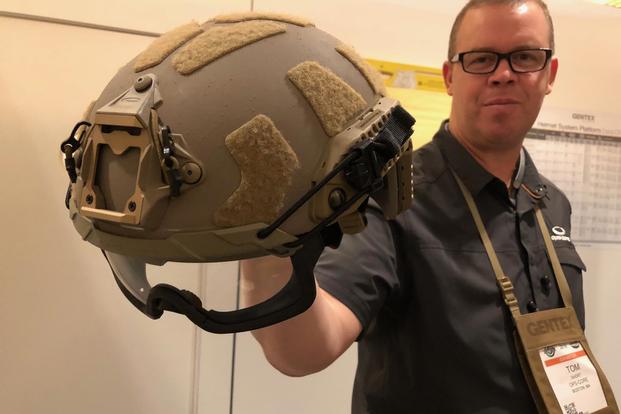LAS VEGAS -- The super lightweight, modular and feature-rich Ops-Core helmets used by special operations troops can inspire a serious case of gear envy from the conventional forces.
And they may get even better.
This week at SHOT Show, parent company Gentex introduced its new Fast SF helmet, its submission for the ongoing U.S. Special Operations Command upgrade program. The helmet retains all the protection of its predecessor, the Ops-Core Fast Maritime, but weighs 10 percent less, said Tom Short, vice president of ground systems for Gentex.
"It's a combination of the reduced weight of the shell, lighter shroud, lighter rails, lighter suspension, lighter retention," he told Military.com. "The more weight that we can take off the head, the less neck strain, it just makes it more comfortable."
The new design, which is now also available commercially, also features more modularity, added comfort in helmet padding, and more versatile rails that allow for the integration of a variety of accessories.
"We took a whole new bottoms-up look at the helmet and redesigned every component to make it better than the current helmet," Short said. "It makes you more comfortable, more stable, has better integration of accessories, and we made it very modular so users can scale up or scale down depending on what they're doing."
The Fast SF weighs in at just 2.25 pounds for a size large.
SOCOM is expected to announce a contract award for its new helmet at the end of the fiscal year.
Meanwhile, some are wondering whether the Marine Corps has long-term designs on Ops-Core technology for conventional forces.
As Military.com has reported exclusively, 2nd Marine Division last year kitted out an East Coast-based "Über Squad" with a wide range of gear borrowed from MARSOC, including Ops-Core helmets with built-in hearing protection, suppressors, and Magpul drum magazines.
The unit, which is still training with the gear ahead of a deployment, was designed to demonstrate the added capability that the sophisticated gear can offer grunts.
And the Marine Corps is well on the way to adopting much of the equipment, including M27 infantry automatic rifles and suppressors.
But Ops-Core helmets may be a way off still. Gentex also makes the Enhanced Combat Helmet, which the Marine Corps picked as its new helmet for all Marines last year. It offers greater protection than its predecessor, and fielding is set to begin this spring.
Short said there were trade-offs when it came to the special operations helmet, which offers less coverage and thinner ballistic protection.
"One [helmet] is not necessarily better than the other; it depends on the mission," he said. "If you knew where you were going to get shot, you'd want the best protection. But 99 percent of the time, when you're not getting shot, you'd like a really lightweight, comfortable helmet. And you don't get to pick and choose when you're going to get shot at."
He said he had read about the Corps' kitted-out squad, but did not know how those tests would affect future plans.
"The Marine Corps is taking a very experimental approach to fielding new equipment, and I certainly can't speak for the Marine Corps as to what they're going to do," he said. "It doesn't matter which helmet, we think we make the best helmet in the world. So I don't see that they can go wrong."
-- Hope Hodge Seck can be reached at hope.seck@military.com. Follow her on Twitter at @HopeSeck.










